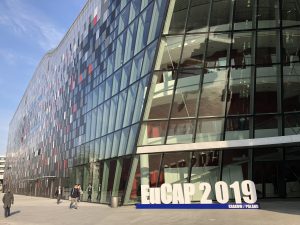This is another blog post in a new series where we talk to SIMULIA employees about current projects they are working on and developments they see in the simulation world. Recently, Marc Rütschlin, a Senior Portfolio Specialist at SIMULIA, attended the European Antennas and Propagation (EUCAP) conference where he learned about a range of topics related to research trends in millimeter wave technology for 5G and wireless transmission. Check out Marc’s full recap of the conference below.
I was fortunate enough to be in Krakow recently for the 13th edition of EUCAP, the European Antennas and Propagation Conference. With over 1200 attendees, an informative combination of plenary talks, technical sessions, scientific workshops, short courses and of course the industrial exhibition, EUCAP ranks among the premier conferences in this field.

The big topics addressed this year – antenna arrays, 5G and radar – reflect the challenges in both the industry today and in future mobile communications and autonomous driving. 5G and radar imaging were popular topics that each had over 60 papers dedicated to them, and over 130 papers focused on the key supporting technology of antenna array design. The continued need for research into antennas, which can support high bandwidths – for operation across multiple bands and geographical regions – was also in clear evidence.

A highlight of the conference was the keynote talk by Renato Lombardi of Huawei, covering a range of topics related to research trends in millimeter wave technology for 5G and wireless transmission. Large antenna arrays are making their way from radar into communication systems, their beam forming capability opening new spectral reuse options by making use of spatial diversity. The important drivers of reducing cost and energy consumption while increasing performance is leading to unconventional architectures like clustered, thinned or sparse antenna arrays. However, the antennas cannot be too unconventional, since manufacturability, and perhaps using simplified production techniques, is key. Innovative antenna design will be required, including, for example, radomes with additional integrated functionality, metasurfaces for beam steering without phase shifters, and integration of filtering and calibration options in the antenna PCB. Deployment of ubiquitous high bandwidth communication links will require a very dense network, but the vision is to use compact Integrated Access & Backhaul (IAB) nodes to enable 5G new radio without densifying the core transport network. IAB will make millimeter-wave 5G possible for mobile devices.
The industrial exhibition also emphasized 5G and antenna arrays examples as core topics, and was well attended by exhibitors and conference goers alike. The mixture of measurement and simulation tool providers, including Dassault Systèmes with our CST Studio Suite product, reflected something observable in all papers of note: measurement and simulation are the symbiotic pairing without which modern antenna design would be unthinkable.

Want to learn more about SIMULIA‘s antenna design software, Antenna Magus? Visit our dedicated page.
